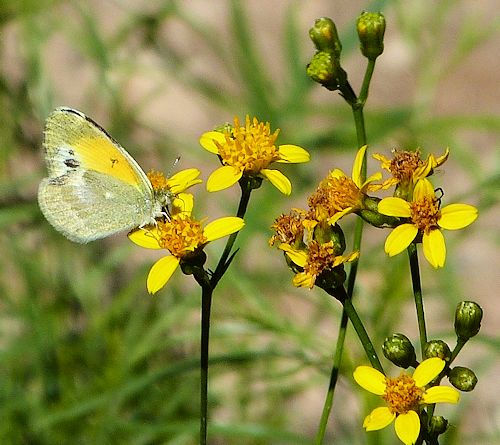Growing Barkleyanthus salicifolius:
Willow Ragwort
Description
Form: Herbaceous stems growing from a woody base (subshrub).
Leaf retention: Evergreen in regions without freezes.
Growth rate: Moderate.
Mature Size: 4-8' (1.2-2.4m) high and wide.
Flowers: Four to five yellow rays surrounding a pale yellow to orange center of many florets, fading to brown, fragrant.
Bloom: Most of the year in regions without freezes.
Fruit: Each floret produces a dry fruit with a single seed (cypsela). The capsule has bristles on one end that loft it into the wind for distribution, somewhat like a dandelion.
Leaves: Green, long, lance-shaped.
Stems: Green, erect, branching.
Wildlife: The flowers attract small butterflies and bees. The foliage is browsed by mammals.
Toxic / Danger: Not reported.
Origin: Arizona to Texas, Mexico, Central America.
Form: Herbaceous stems growing from a woody base (subshrub).
Leaf retention: Evergreen in regions without freezes.
Growth rate: Moderate.
Mature Size: 4-8' (1.2-2.4m) high and wide.
Flowers: Four to five yellow rays surrounding a pale yellow to orange center of many florets, fading to brown, fragrant.
Bloom: Most of the year in regions without freezes.
Fruit: Each floret produces a dry fruit with a single seed (cypsela). The capsule has bristles on one end that loft it into the wind for distribution, somewhat like a dandelion.
Leaves: Green, long, lance-shaped.
Stems: Green, erect, branching.
Wildlife: The flowers attract small butterflies and bees. The foliage is browsed by mammals.
Toxic / Danger: Not reported.
Origin: Arizona to Texas, Mexico, Central America.
Cultivation and Uses
USDA hardiness zones: USDA 9-12.
Heat tolerant: Yes.
Drought tolerant: Yes.
Sun: Full sun to light shade.
Soil: Well draining, dry, low in organic content, pH 6.1-9.0 (slightly acidic to highly alkaline). Fertilizing this plant reduces its attractiveness to butterflies.
Water after becoming established: Once or twice a month.
Planting: It can be grown in a large container.
Prune: In winter, prune to shape.
Litter: Low.
Propagation: Seed, cuttings.
Uses: Ornamental, butterfly attractor.
USDA hardiness zones: USDA 9-12.
Heat tolerant: Yes.
Drought tolerant: Yes.
Sun: Full sun to light shade.
Soil: Well draining, dry, low in organic content, pH 6.1-9.0 (slightly acidic to highly alkaline). Fertilizing this plant reduces its attractiveness to butterflies.
Water after becoming established: Once or twice a month.
Planting: It can be grown in a large container.
Prune: In winter, prune to shape.
Litter: Low.
Propagation: Seed, cuttings.
Uses: Ornamental, butterfly attractor.
Comments
This plant is a member of the Daisy family (Asteraceae) and is the only species within the Barkleyanthus genus. Do not fertilize this plant or butterflies will lose interest. The yellow and gray butterfly is a Dainty Sulphur. The brown butterflies are Texan Crescents.
Do you have additional information or a different experience for these plants that you would like to share? Email info@GardenOracle.com. All contributions are welcome and appreciated.
This plant is a member of the Daisy family (Asteraceae) and is the only species within the Barkleyanthus genus. Do not fertilize this plant or butterflies will lose interest. The yellow and gray butterfly is a Dainty Sulphur. The brown butterflies are Texan Crescents.
Do you have additional information or a different experience for these plants that you would like to share? Email info@GardenOracle.com. All contributions are welcome and appreciated.



Latest update: September, 2024
© 2008-2025 by GardenOracle.com

